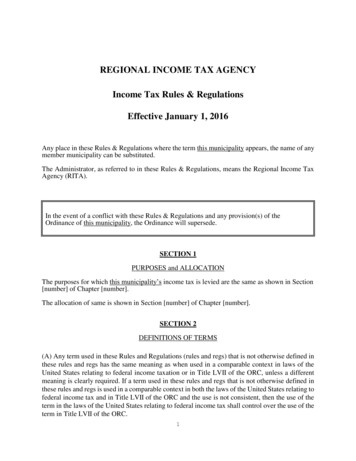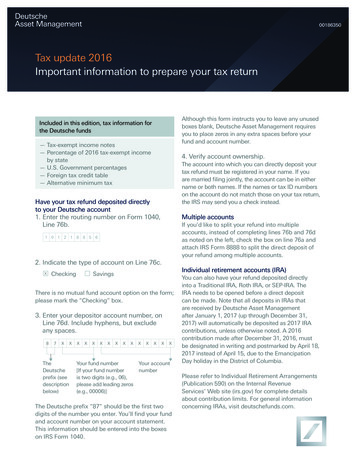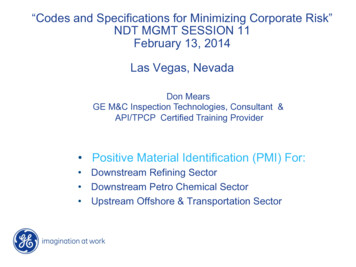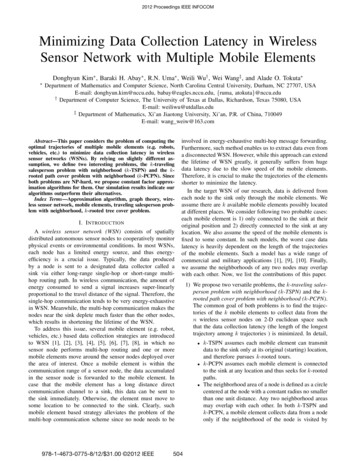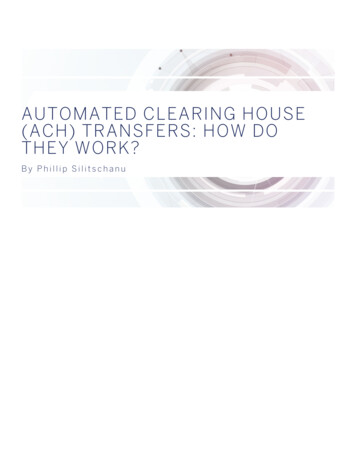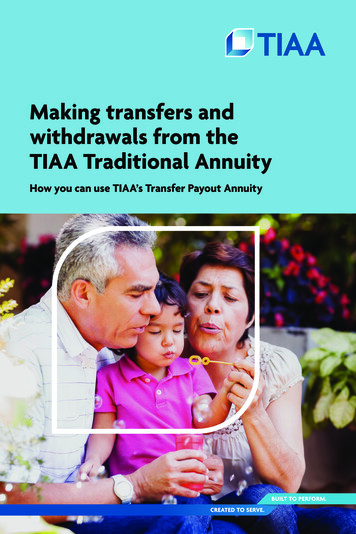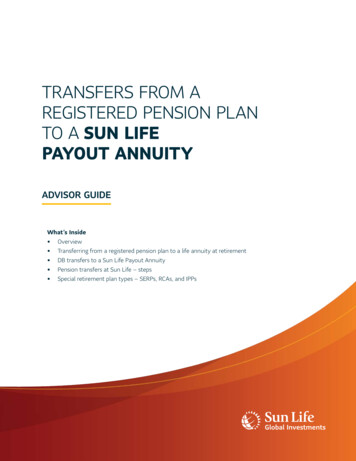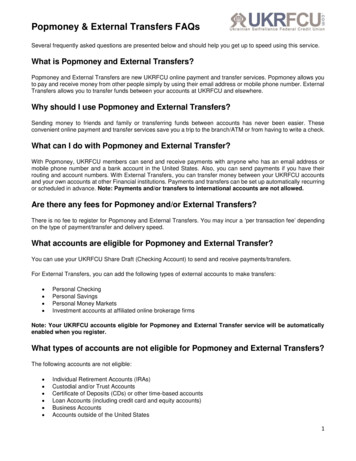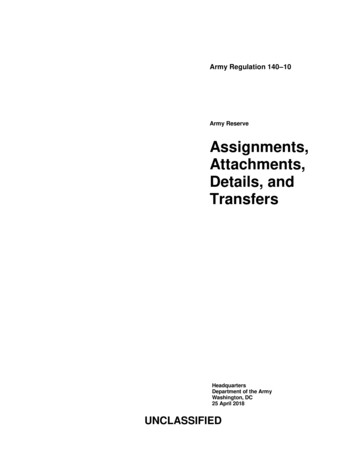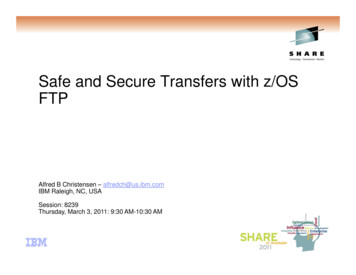
Transcription
Presenting a live 90-minute webinar with interactive Q&AMinimizing Tax on Trust Transfers ThroughBasis AdjustmentEstate Asset Basis Management: Trust Transfers, Credit Shelter Trusts, andPost Mortem ActionsWEDNESDAY, JUNE 20, 20181pm Eastern 12pm Central 11am Mountain 10am PacificToday’s faculty features:James G. Blase, CPA, JD, LLMAdjunct Professor, Villanova University School of LawPrincipal, Blase & Associates, LLC, St. Louis, Mo.The audio portion of the conference may be accessed via the telephone or by using your computer'sspeakers. Please refer to the instructions emailed to registrants for additional information. If youhave any questions, please contact Customer Service at 1-800-926-7926 ext. 1.NOTE: If you are seeking CPE credit, you must listen via your computer — phone listening is nolonger permitted.
Tips for Optimal QualityFOR LIVE EVENT ONLYSound QualityIf you are listening via your computer speakers, please note that the qualityof your sound will vary depending on the speed and quality of your internet connection.If the sound quality is not satisfactory, you may listen via the phone: dial1-866-961-9091 and enter your PIN when prompted. Otherwise, pleasesend us a chat or e-mail sound@straffordpub.com immediately so we can address theproblem.If you dialed in and have any difficulties during the call, press *0 for assistance.NOTE: If you are seeking CPE credit, you must listen via your computer — phonelistening is no longer permitted.Viewing QualityTo maximize your screen, press the F11 key on your keyboard. To exit full screen,press the F11 key again.
Continuing Education CreditsFOR LIVE EVENT ONLYIn order for us to process your continuing education credit, you must confirm yourparticipation in this webinar by completing and submitting the AttendanceAffirmation/Evaluation after the webinar.A link to the Attendance Affirmation/Evaluation will be in the thank you email that youwill receive immediately following the program.For CPE credits, attendees must participate until the end of the Q&A session andrespond to five prompts during the program plus a single verification code. In addition,you must confirm your participation by completing and submitting an AttendanceAffirmation/Evaluation after the webinar.For additional information about continuing education, call us at 1-800-926-7926 ext. 2.
Program MaterialsFOR LIVE EVENT ONLYIf you have not printed the conference materials for this program, pleasecomplete the following steps: Click on the symbol next to “Conference Materials” in the middle of the lefthand column on your screen. Click on the tab labeled “Handouts” that appears, and there you will see aPDF of the slides for today's program. Double click on the PDF and a separate page will open. Print the slides by clicking on the printer icon.
Minimizing Tax on TrustTransfers Through BasisAdjustmentJAMES G. BLASE, CPA, JD, LLMADJUNCT PROFESSOR, VILLANOVA UNIVERSITY SCHOOL OF LAWPRINCIPAL, BLASE & ASSOCIATES, LLC, ST. LOUIS, MOJIMBLASE@BLASELAW.COM
Use of Trusts in EstatePlanning Death tax protection, including state estate,inheritance and GST taxes. Lawsuit protection. Protection for minors and older children andother beneficiaries. Divorce and remarriage protection. Special needs trusts. Second marriage situations.6
Estate Tax Planning Underthe New Tax Law For large estates, need to ensure that each spouse’s estatefunded with up to the current 11 million exemption amount. Relying on the spousal portability election to ensure the“double exemption” for married couples carries with itsignificant risks. Portability may not be available if surviving spouse remarries.Portability not available to protect future growth.Portability not available for GST tax purposes.Portability may not be available for state death tax purposes.Portability eliminates asset protection.Portability may not make sense in second marriage situations.7
Income Tax Planning Under the New TaxLaw Trusts with Zero Inclusion Ratio Attorneys preparing new trust instrumentsintended to have a GST tax inclusion ratio ofzero, which will now include most bypass orcredit shelter trusts and most trusts forchildren or more remote descendants, mustnow also consider the ever increasinglikelihood that the estate of the primarybeneficiary of the trust won’t be subject tofederal estate tax.8
Trusts with Zero Inclusion Ratio Given the fact that most states no longerimpose an estate or inheritance tax, as well asthe ever-widening gap between federal andstate transfer tax exemptions in those statesthat do impose either or both taxes, a renewedemphasis on the income tax aspects of estateplanning, and specifically income tax basisplanning, is needed if trusts are still desirable.9
Trusts with Zero Inclusion Ratio Achieving new income tax basis if a beneficiaryof a zero inclusion ratio trust should die duringthe term of the trust involves granting thebeneficiary a conditional testamentary generalpower of appointment (POA) (typically limitedto the creditors of the beneficiary’s estate) overthe trust assets, to the extent the same won’tresult in any federal or state estate orinheritance tax liability to the beneficiary’sestate.10
Trusts with Zero Inclusion Ratio An exception to this automatic rule shouldapply when the beneficiary is survived by aspouse, however, to preserve the full availabilityof the federal spousal portability election, whendesirable. Instead of using an automatic testamentarygeneral POA, during the beneficiary’s lifetime anindependent trustee can be granted thediscretionary ability to add the power, to the extentit’s deemed beneficial, as well as the discretionaryability to remove it.11
Trusts with Zero Inclusion Ratio If an individual is a beneficiary of morethan one trust, the maximum conditionaltestamentary general POA should beallocated among the relevant trusts,based on the fair market value of therespective trust assets at the beneficiary’sdeath.12
Trusts with Zero Inclusion RatioIt’s important to fashion the testamentarygeneral POA in a manner that applies to themost appreciated assets of the trust first, towipe out the most potential capital gains taxpossible in the event a testamentary generalPOA over the entire trust would generateestate or inheritance taxes. It may also be advisable to structure thetestamentary general POA so that it doesn’tapply to any trust assets that have depreciatedin value over their historical income tax basis. 13
Trusts with Zero Inclusion Ratio The conditional testamentary general POAshould also contain limitations that will eliminatethe possibility that the beneficiary’s estate orthe trust will be automatically subject toincome tax on any gain attributable to anyportion of the remaining trust assets (shouldsuch a law ever be enacted).14
Trusts with Zero Inclusion Ratio With the ever-increasing prospect of some dayhaving a nation with no federal (at least) estatetax, or at least a change in the Section 1014rules to eliminate GPAs as a basis step-uptriggering event, it may be wise for the draftingattorney to also assume in his or her draftingthat the mere existence of a testamentaryconditional general POA (especially one that’slimited to creditors of the beneficiary’s estate)may no longer be sufficient to create incometax basis step-up under Section 1014.15
Trusts with Zero Inclusion Ratio Another alternative in zero inclusion ratiosituations may be to grant the beneficiary atestamentary limited POA over the trust assets,and then allow the beneficiary to intentionallyviolate IRC Section 2041(a)(3) (the so-called“Delaware tax trap”), to the extent it won’tcause estate or inheritance taxes to bepayable at the beneficiary’s death.16
Trusts With Zero InclusionRatio SAMPLE CREDIT SHELTER TRUST FORM - PART 1: In addition, unless assets have passed to the trust asa result of disclaimer by the surviving spouse, or bythe surviving spouse's legal representative, after thedeath of the deceased spouse, and except asotherwise provided in Sections and ofARTICLE hereof, if the surviving spouse is notsurvived by a surviving spouse (as that term isdefined for purposes of Section 2056 of the InternalRevenue Code, or any successor section thereto),then to the extent it will not result in17
Trusts With Zero InclusionRatio SAMPLE CREDIT SHELTER TRUST FORM - PART 2: (i) the surviving spouse’s estate being liable for anyfederal or state estate or inheritance taxes (assuming noalternate valuation date or similar elections, qualifieddisclaimers, or deductible administration expenses), (ii)the surviving spouse's estate being liable to reimburseany government for any assistance or other benefitsprovided the surviving spouse during the survivingspouse’s lifetime, (iii) the surviving spouse’s estate or thetrust being automatically subject to income tax on anygain attributable to any portion of the remaining trustassets, or18
Trusts With Zero InclusionRatio SAMPLE CREDIT SHELTER TRUST FORM - PART 3: (iv) a reduction in the federal income tax basis of anyasset over its historical federal income tax basis, thesurviving spouse shall have the power to appoint thoseremaining trust assets, if any, beginning with the asset orassets having the greatest amount of built-inappreciation (calculated by subtracting the trust'sincome tax basis from the fair market value on the dateof death of the surviving spouse), as a percentage ofthe fair market value of such asset or assets on the dateof death of the surviving spouse,19
Trusts With Zero InclusionRatio SAMPLE CREDIT SHELTER TRUST FORM - PART 4: to the creditors of the surviving spouse's estate (or to thesurviving spouse's estate and any one or more individualsand/or entities, including a trust or trusts, if the power todistribute such assets to the creditors of the surviving spouse'sestate is not sufficient to cause a federal income tax basisadjustment under IRC Section 1014, or any successor sectionthereto, at the surviving spouse's death), [DON'T INCLUDE THEPARENTHETICAL IN CERTAIN SITUATIONS WHERE SURVIVINGSPOUSE SHOULD NOT BE GIVEN SUCH BROAD POWERS, E.G.SECOND MARRIAGE] utilizing the same appointmentprocedure described in subsection 2.1, above;20
Trusts With Zero InclusionRatio SAMPLE CREDIT SHELTER TRUST FORM - PART 5: PROVIDED, HOWEVER, that if this trust has been or willbe divided into two separate trusts for federalgeneration-skipping transfer tax purposes, the survivingspouse's foregoing additional power of appointmentshall apply (i) first to the trust having an inclusion ratio,as defined in Section 2642(a) of the Internal RevenueCode, or any successor section thereto, of other thanzero, but only to the extent such trust is not otherwisealready includible in the surviving spouse's estate forfederal estate tax purposes, pursuant to the otherprovisions of this trust instrument, and (ii) next to thetrust having an inclusion ratio, as defined in Section2642(a) of the Internal Revenue Code, or anysuccessor section thereto, of zero;21
Trusts With Zero InclusionRatio SAMPLE CREDIT SHELTER TRUST FORM - PART 6: PROVIDED FURTHER, HOWEVER, that if the survivingspouse is the beneficiary of more than one trust whichincludes a provision similar to this sentence, under nocircumstance shall the surviving spouse’s estate beliable for any federal or state estate or inheritance taxas a consequence of the surviving spouse’s foregoingadditional power of appointment, and if necessary tocarry out this intent, the extent of the surviving spouse’sforegoing additional power of appointment shall bereduced in proportion to the value of all other trustassets subject to a similar additional power ofappointment, or by a greater amount, if furthernecessary.22
Trusts With Zero InclusionRatio SAMPLE CREDIT SHELTER TRUST FORM - PART 7: If the surviving spouse is survived by a surviving spouse(as that term is defined for purposes of Section 2056 ofthe Internal Revenue Code, or any successor sectionthereto), the surviving grantor shall only possess thesurviving spouse's foregoing additional power ofappointment to the same or lesser extent that thetrustee (other than the surviving spouse and other thana trustee who is "related or subordinate" to the survivingspouse within the meaning of current Section 672(c) ofthe Internal Revenue Code (substituting "the survivingspouse" for "the grantor" in said Section)) shall direct byinstrument in writing filed with the trust during thesurviving spouse’s lifetime and not revoked by saidtrustee prior to the surviving spouse's death;23
Trusts With Zero InclusionRatio SAMPLE CREDIT SHELTER TRUST FORM - PART 8: PROVIDED, HOWEVER, that the trustee shall notpossess the aforedescribed power to direct if thesurviving spouse appointed the trustee who orwhich possesses the aforedescribed power todirect, and if as a consequence the survivingspouse is deemed to possess the aforedescribedpower to direct for federal or state estate tax, gifttax, generation-skipping transfer tax, inheritance taxor other transfer tax purposes.24
Trusts With Zero InclusionRatio SAMPLE CREDIT SHELTER TRUST FORM - PART 9: In exercising said trustee's broad discretionary power indetermining whether and to what extent the survivingspouse shall possess the aforesaid power of appointment ifthe surviving spouse is survived by a surviving spouse, saidtrustee shall be primarily concerned with minimizing overallincome and transfer taxes to the surviving spouse's estateand to recipients of the trust assets after the survivingspouse’s death, and with minimizing the liability of thesurviving spouse's estate to reimburse any government forany assistance or other benefits provided the survivingspouse during the surviving spouse's lifetime.25
Trusts With Inclusion RatioOther Than Zero Primary focus shifts to minimizing total federal ANDSTATE estate, inheritance AND generation-skippingtransfer taxes. See: ome-tax-and-gst-planning-under-newtax-law27
Dealing with ExistingIrrevocable Trusts Many clients are beneficiaries of existing irrevocabletrusts that, typically, won’t include any of the abovedescribed income tax minimizing provisions. In thesesituations, if the governing law of the trust is that of astate that has passed so-called “decanting trust”legislation, it may be possible, depending on how thetrust and the state’s particular decanting trust statuteeach read, to prepare a new irrevocable trust that willinclude one or more of these provisions, and thentransfer the assets from the existing irrevocable trust tothe “decanting trust.”28
Dealing with ExistingIrrevocable Trusts Although a complete discussion of state decantingtrust legislation is beyond the scope of this presentation,in states that impose a fiduciary duty on the trusteeprevious to transferring assets to a decanting trust,ample benefit to all of the beneficiaries of the trust,both current beneficiaries and remaindermen, shouldbe easy to demonstrate. The larger problem will beensuring that the particular trust document anddecanting trust statute permit the contemplatedtransfer.29
Dealing with ExistingIrrevocable Trusts Another potential route for achieving income taxbenefits for an existing irrevocable trust may arise if theexisting trust instrument includes a so-called “trustprotector” clause. Depending on how the particularclause is crafted, it may include within its scopepermissible amendments to the trust to achieve incometax advantages for the trust and its beneficiaries. Somestates may also have “trust modification” statutes thatpermit revisions to irrevocable trust documents underspecified circumstances, with or without courtapproval, including revisions to achieve taxadvantages.30
Dealing with ExistingIrrevocable Trusts An estate-planning attorney must also be mindful of allthe potential transfer tax issues that may attendtransferring trust assets to a decanting trust, exercising atrust protector power, or otherwise participating in amodification of an irrevocable trust. These potentialtransfer tax issues include generation-skipping transfertax issues involving grandfathered and other currentlyexempt trusts, as well as other estate and gift taxquestions. In most situations it should be possible tonavigate these potential transfer tax issues, however,through careful analysis and planning.31
Dealing with ExistingIrrevocable Trusts If the existing irrevocable trust happens to include atestamentary limited POA in the beneficiary, another toolthe beneficiary may have to at least achieve a new incometax basis for his or her heirs in the trust’s most appreciatedassets at his or her death, is to follow the plan (outlinedabove) of intentionally violating Section 2041(a)(3), at leastto the extent of the most appreciated assets of the trust, butwithout causing estate or inheritance taxes to be payable atthe beneficiary’s death. For this planning technique tosucceed, however, it must first be determined that thestrategy isn’t already foreclosed by the provisions of theapplicable trust document or by applicable state law.32
Dealing with ExistingIrrevocable Trusts Finally, if all else fails, and the client would stilllike to pursue achieving a basis step-up atdeath for all of some of the assets owned by anexisting irrevocable trust, following a plan forterminating the existing irrevocable trusts, inwhole or in part, may be produce benefits.33
Creating Stepped-up BasisWhen a Parent Dies A possible opportunity exists today for a child tohave the income tax basis of his or her ownhighly appreciated assets stepped-up when hisor her parent dies. This possibility exists becauseof the current 11.18 million federal estate andgift tax exemption, along with the estate taxportion rules.34
Creating Stepped-up BasisWhen a Parent Dies The concept is to transfer the client’s most appreciatedassets to an irrevocable trust for the benefit of others(including a spouse and/or children), and grant the parent ageneral testamentary power of appointment over the trust’smost appreciated assets, though capped so that adverseestate tax consequences cannot occur at the parent’sdeath. At the parent’s death, the portion of the trust subjectto the parent’s general testamentary power of appointmentflows back into a trust for the benefit of the client and his orher family, and the parent’s unused generation-skippingtransfer tax exemption is applied to the trust.35
Creating Stepped-up BasisWhen a Parent Dies Similar to the planning done for a terminally ill spouse(discussed below), the trust should be drafted to minimizethe possible effects of the Section 1014(e) one-year rule.Thus, as to assets transferred to the trust by the client withinone year of the parent’s death only, after the parent’sdeath the trustee should not be the client, and the trusteeshould be given absolute discretion over trust distributions ofincome and principal. Further, as to this same portion thetrustee should be permitted to take into consideration theclient’s other resources (including any other assets passing toor for the benefit of the client at the parent’s death) beforemaking any distributions to or for the benefit of the client.36
Creating Stepped-up BasisWhen Parent Dies In addition to achieving the stepped-up income tax basisgoal, another desirable result of this planning technique isthat all appreciation in the value of the trust corpusoccurring from the date of the transfer until the client’sdeath will escape estate taxes at the child’s death, due tothe lifetime use of the client’s gift tax exemption and theallocation of the parent’s generation-skipping transfer taxexemption to the trust. This is all despite the fact that theclient will normally be able to serve as trustee and retainaccess to the economic benefits of the transferred assetsafter the parent’s death (subject to the abo
Jun 20, 2018 · James G. Blase, CPA, JD, LLM Adjunct Professor, Villanova University School of Law Principal, Blase & Associates, LLC, St. Louis, Mo. Tips for Optimal Quality Sound Quality If you are listening via your computer speakers, please note that the quality . income tax basis from the fair mark
